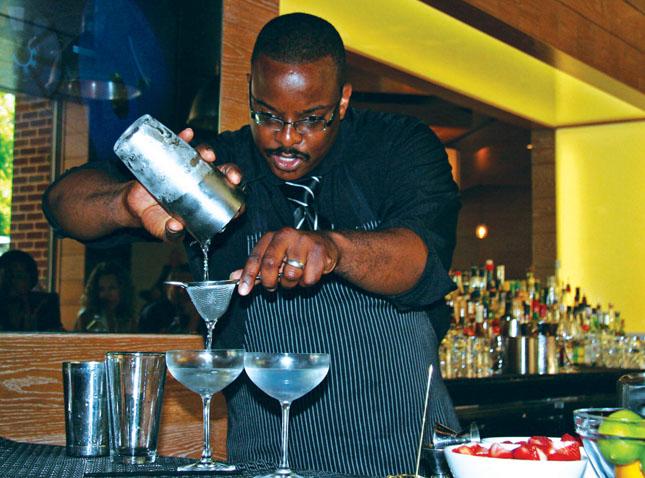Stirred, Not Shaken
By • July 26, 2011 0 1229

The steak and martini is a classic food and cocktail pairing. It’s something your grandfather would have ordered at an old boy’s club steakhouse, and it’s something you would feel comfortable ordering today with a cut of Japanese wagyu beef.
So it was no surprise that the martini and its various incarnations were highlighted during a recent mixology seminar at Georgetown’s Bourbon Steak restaurant. Bourbon Steak’s bartender Duane Sylvestre taught the class, in which guests received a primer on basic bar techniques, an overview of various spirits and the history behind many cocktails.
The martini, according to Sylvestre, is one of the most misunderstood cocktails. The classic martini consists of gin and dry vermouth, stirred and served with either olives or a lemon twist. But over the years, the drink has transformed into different things.
The vodka martini, in particular, has evolved from its original form. While a traditional vodka martini should be made with vermouth, Sylvestre says that most vodka drinkers prefer theirs without. However, many people mistakenly order an extra dry vodka martini, believing that the term means “no vermouth,” when it actually means the opposite.
A “dry” martini refers to the addition of dry vermouth. This term came into play years ago as a way to distinguish the martini from its forerunner, the Martinez, which was a gin and sweet vermouth mixture. Therefore, the term “dry” came to mean dry vermouth and extra dry came to signify extra vermouth.
Even though James Bond has dictated the martinis should be shaken, not stirred, Sylvestre is a stickler for stirring. His rule is that any cocktails containing only alcoholic ingredients, such as gin and vermouth, should always be stirred, while drinks that include non-alcoholic mixers should be shaken.
However, he makes an exception with vodka martinis. “Most vodka drinkers want their vodka cold and served straight up,” he says so he lets the market dictate how the drink is prepared.
After making a vodka martini for the crowd, Duane mixed a classic gin martini with a twist using Plymouth gin, which he calls a mild and agreeable gin. “It’s going to add complexity, depth and character,” he said, “without the gin taking over the cocktail.”
The choice of garnish — either an olive or lemon twist — is a simple matter of taste, unless you are ordering a dirty martini, which includes olive juice.
Duane taught the class how to make a lemon garnish by using a vegetable peeler. After cutting the peel from the fruit, he stretched the skin around the rim of the glass in order to extract the citrus oils before dropping it into the martini.
When I got a chance to sample the finished tipple I could see the citrus oils floating in the drink. The added hint of lemon provided a refreshing twang combined with the gin and vermouth. The timeless classic was an ideal balance of bitter, citrus, dry and sweet.
Gin Martini
2 ounces Plymouth gin
1 ounce dry vermouth
Stir well. Serve in a martini glass. Garnish with lemon peel or olives.
Readers may sample the martini at Bourbon Steak restaurant, located in the Four Seasons Hotel at 2800 Pennsylvania Ave. Ingredients to make the martini may be purchased at Dixie Liquor, 3429 M St.

